
views
Converting 24-Hour Time to 12-Hour Time
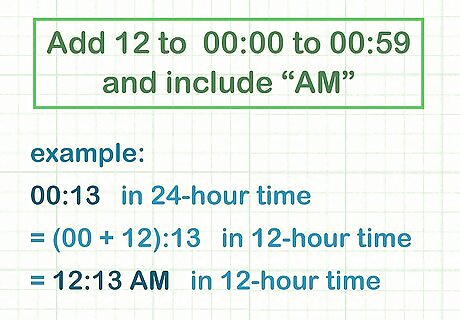
Add 12 to the first hour of the day and include “AM.” In 24-hour time, midnight is signified as 00:00. So, for midnight hour, add 12 and the signifier “AM” to convert to 12-hour time. This means that, for example, 00:13 in 24-hour time would be 12:13 AM in 12-hour time.Did You Know? The abbreviations “AM” and “PM” are Latin in origin. “AM” stands for “ante meridiem” which means “before noon” while PM stands for “post meridiem” which means “after noon.”
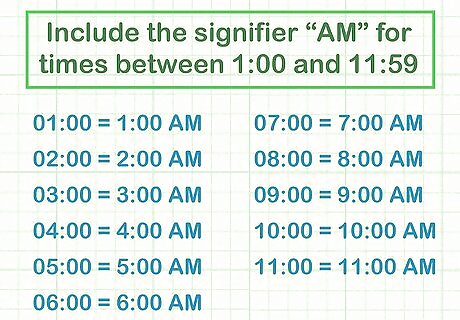
Include the signifier “AM” for times between 1:00 and 11:59. Since 24-hour times moves from 00:00 (midnight) to 1:00, all you have to do is add “AM” to the time from 1:00 up until 11:59. You can also eliminate any leading zeroes. For instance, 06:28 in 24-hour time is equivalent to 6:28 AM in 12-hour time. This means that: 01:00 = 1:00 AM 02:00 = 2:00 AM 03:00 = 3:00 AM 04:00 = 4:00 AM 05:00 = 5:00 AM 06:00 = 6:00 AM 07:00 = 7:00 AM 08:00 = 8:00 AM 09:00 = 9:00 AM 10:00 = 10:00 AM 11:00 = 11:00 AM
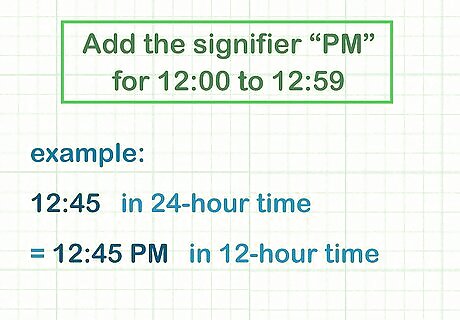
Add the signifier “PM” for 12:00 to 12:59. For the noon hour, simply add “PM” to the end of the 24-hour time to make it 12-hour time. So, for example, 12:45 would become 12:45 PM.

Subtract 12 from 13:00 to 23:59 and include “PM.” For the hours after noon, subtract 12 hours from the 24-hour time. Then add “PM” at the end. For instance, to convert 14:36 to 12-hour time, subtract 12, which is 2:36, then add “PM.” There’s no need to include a leading zero for single-digit numbers in 12-hour time. Therefore: 13:00 = 1:00 PM 14:00 = 2:00 PM 15:00 = 3:00 PM 16:00 = 4:00 PM 17:00 = 5:00 PM 18:00 = 6:00 PM 19:00 = 7:00 PM 20:00 = 8:00 PM 21:00 = 9:00 PM 22:00 = 10:00 PM 23:00 = 11:00 PM
Changing 12-Hour Time to 24-Hour Time
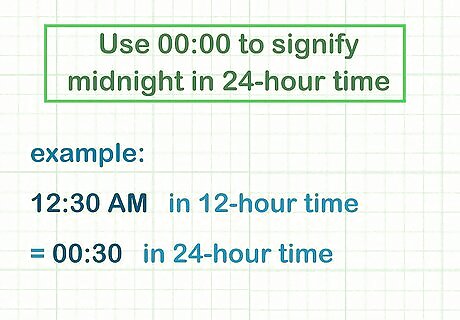
Use 00:00 to signify midnight in 24-hour time. Rather than using “12:00” twice in a 24-hour period, like in 12-hour time, 24-hour time uses “00:00” for the midnight hour. That means all you need to do is record the minutes. For example, 12:30 AM becomes 00:30.Did You Know?There’s no 24:00 in 24-hour time since it moves from 23:00 (11:00 PM) to 00:00 (12:00 AM).
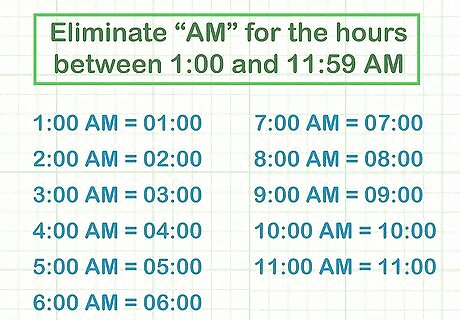
Eliminate “AM” for the hours between 1:00 and 11:59 AM. Changing the hours between midnight and noon from 12-hour time to 24-hour time is super simple. All you have to do is take away the “AM” signifier. If the hour number is a single digit, add a leading zero. So, for example, 6:00 AM is 06:00 and 10:15 AM is 10:15. Therefore: 1:00 AM = 01:00 2:00 AM = 02:00 3:00 AM = 03:00 4:00 AM = 04:00 5:00 AM = 05:00 6:00 AM = 06:00 7:00 AM = 07:00 8:00 AM = 08:00 9:00 AM = 09:00 10:00 AM = 10:00 11:00 AM = 11:00
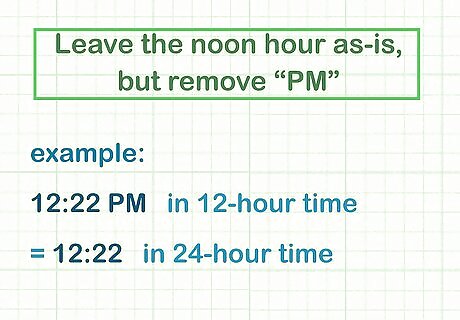
Leave the noon hour as-is, but remove "PM." You don't need to do anything to change 12:00 PM to 12:00 in 24-hour time, except for eliminate the "PM" signifier. So, 12:22 PM would simply be 12:22, for instance.
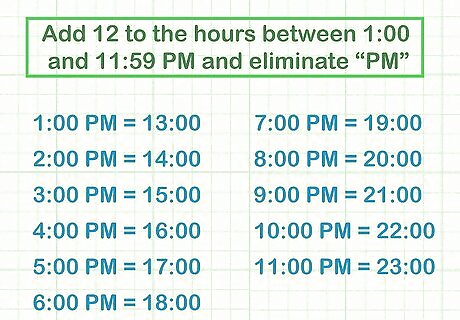
Add 12 to the hours between 1:00 and 11:59 PM and eliminate "PM." For the afternoon, evening, and night hours, simply add 12 to the 12-hour time to convert it to 24-hour time. Also, eliminate “PM.” That means that 2:57 PM would become 14:57 and 11:02 would become 23:02. Therefore: 1:00 PM = 13:00 2:00 PM = 14:00 3:00 PM = 15:00 4:00 PM = 16:00 5:00 PM = 17:00 6:00 PM = 18:00 7:00 PM = 19:00 8:00 PM = 20:00 9:00 PM = 21:00 10:00 PM = 22:00 11:00 PM = 23:00














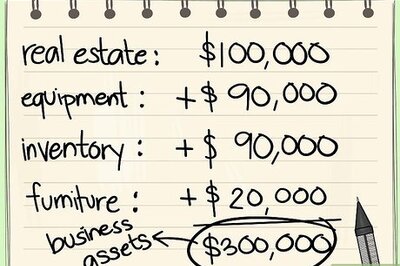




Comments
0 comment